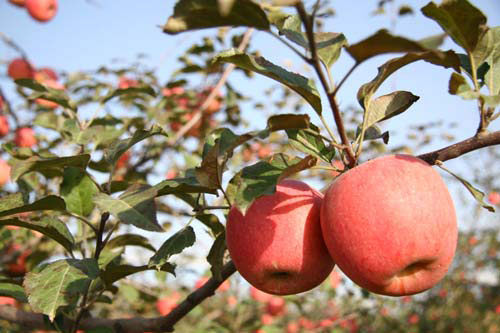Yan'an journal - Day 4
|
Apples grow at an orchard in Luochuan, Shaanxi Province. [Photo: CRIENGLISH.com] |
Apples in Luochuan County
Driving through the rolling terraced hills, cornfields and small villages around Yan'an (A Trip to Yan'an), the countryside gave way to orchard after orchard of apple trees, their branches heavy with round, bright red fruit.
Between the Tomb of the Yellow Emperor and the former stomping grounds of Mao Zedong, the humble city of Yan'an can claim a history richer than many places in the world. But with all that now far in the past, the people here have had plenty of time to think about what's in their future. That's where apples come in. In the 1970s, a group of visiting scientists pronounced the conditions here perfect for growing this fruit. From then on, people here devoted themselves to apples, and now they are aiming to make theirs world famous.
In Luochuan, a county outside of Yan'an where nearly the entire population earns their livelihood from the apple industry, the orchards stretch as far as the eye can see. Workers pick the fruit until it piles by the hundreds along the roadside. The farmers we visit are eager to show us the tricks of their trade, like lining the orchard ground with silver reflective paper so that sunlight reaches every side of the apple, turning it the perfect shade of red; or how they also raise pigs on their land so they can use the manure as organic fertilizer. We stop to meet some workers who have come from another county for the harvest season. They sit outside on this sunny autumn day, sorting and packing apples into boxes that will be loaded onto trucks and sent all over China, or even exported to countries all over the world. They live in temporary dorms here until its time to go back home, and can earn 50 renminbi a day for eight hours of this work while the harvest season lasts.
An exhibition hall in the town of Luochuan displays the local government's plans for the industry and the town. Scale models show the planned development projects across the area, and architectural drawings display modern mixed commercial and residential projects, including high rises that would blend right in in affluent parts of Beijing. For now though, most locals still live in humble traditional houses, and the grand infrastructure projects are still just ideas.
 0
0 








Comments